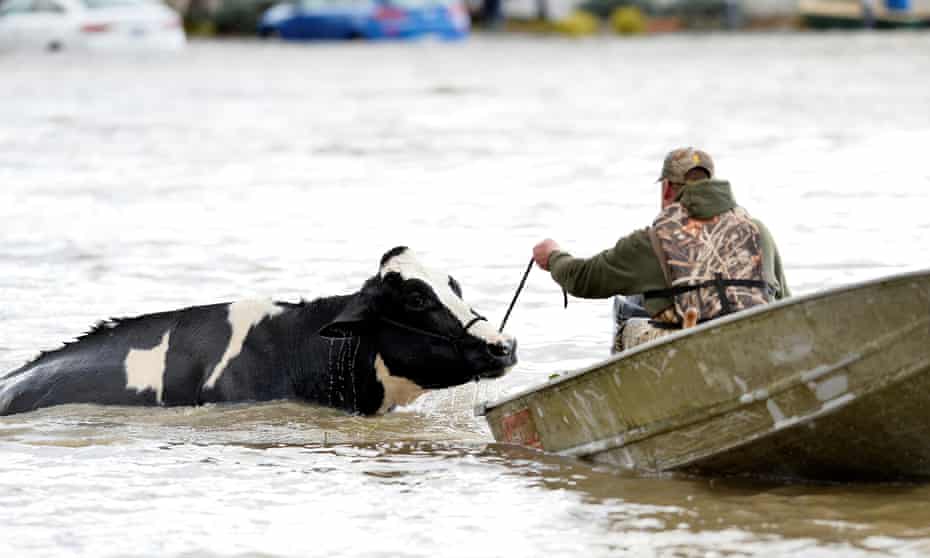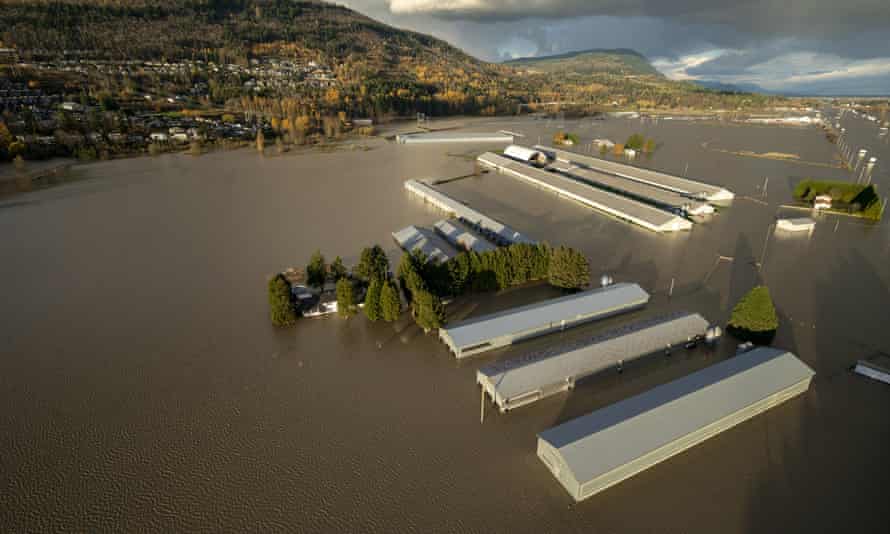Canada floods leave thousands of farm animals dead and more trapped
Frantic rescue operation to save livestock from submerged farms underway, with many animals in desperate need of food

Thousands of farm animals have died and many more are trapped by floods in desperate need of food and water after the Pacific north-west storm battered a major hub of Canadian agriculture.
Torrential rains pummelled swathes of western Canada’s British Columbia and Washington state in the US in recent days – dumping a month’s worth of rain in two days in some areas – causing floods and mudslides that swallowed stretches of highways and forced the evacuation of thousands of people. One person has been killed and several have been reported missing.
Abbotsford, one of Canada’s most intensively and diversely farmed areas, was among places hardest hit. Home to more than 1,200 farms, it supplies half of the dairy, eggs and poultry consumed by British Columbia’s 5.2 million residents.
Aerial footage showed several barns engulfed by flood waters. Farmers and residents have been frantically scrambling to save their animals from rising waters, resorting to motorboats and jetskis to tow partly submerged cows one by one to higher ground.

Many of the farms are in Sumas Prairie, a low-lying fertile stretch of land created by the draining of a lake nearly a century ago. An evacuation order on Tuesday included 121 dairy and poultry farms, according to farmers associations.
Local officials pleaded with about 300 people who defied the order. “If you are still on Sumas Prairie, you need to leave,” said Henry Braun, the mayor of Abbotsford. “I know it’s hard for farmers to leave their livestock, but people’s lives are more important to me right now than livestock or chickens.”
Lana Popham, minister of agriculture for British Columbia, said the storm had battered a key part of the province’s farmland, setting off an animal welfare crisis.
“There are probably hundreds of farms that have been affected by flooding. Some are still underwater, some are on dry locations and we have thousands of animals that have perished,” she said. “We have many, many more that are in difficult situations.”
Officials were racing to carve out routes in impassable areas to get veterinarians to stranded animals, she said. “There will have to be euthanizations that happen, but there are also animals that have survived that are going to be in critical need of food in the next 24 hours.”
Popham said she had spent the past two days on video calls with farmers affected. “Some of them are in their barns, and some of their barns are flooded and you can see the animals are deceased,” she said. “It’s heartbreaking.”
She said while some farmers had towed cows out of the flood waters, the rescued animals were “not in good shape” after their ordeal. “I can also tell you that many farmers attempted to move animals and then had to walk away because the roads were disappearing beneath them.”
In Abbotsford, Braun said it was too early to say how many animals had died. But a helicopter tour had given a dire picture of the storm’s impact. He said: “I saw barns that looked like they were half full of water. I can’t imagine that there are any birds left alive, but we don’t have those numbers.” In 2010, the area raised more than 9 million poultry birds.
Around 9,000 cows were housed at the 60 dairy farms affected by the Sumas Prairie evacuation order, said Holger Schwichtenberg, the chair of the BC Dairy Association.
As news of the order spread, he said dairy farmers had rallied together to stem the losses. “Countless farmers with trucks and trailers started hauling cattle out of the affected areas to farms like mine. We’re in a safe place, so we had 40 cows delivered to us.” He was unable to say how many cows had been moved to higher ground or how many had been left behind.
Farmers have been unable to get their milk to market, forcing some to dump thousands of litres. Schwichtenberg said: “The milk on our farm got dumped last night because there’s no way for the trucks to get here. The roads are impassable.”
The powerful storm comes less than six months after British Columbia was overwhelmed by record-high temperatures that killed more than 500 people and led to wildfires that gutted an entire town.
“We went through the heat dome and pretty much drought conditions all summer long and now we get the complete flipside,” he said.
Sign up for the Animals farmed monthly update to get a roundup of the biggest farming and food stories across the world and keep up with our investigations. You can send us your stories and thoughts at animalsfarmed@theguardian.com